Abstract
Photosynthesis is one of the essential processes for life on the planet. Photosynthesis cannot be measured directly because this complex process involves different variables; therefore, if some variables of interest are integrated and measured, photosynthesis can be inferred through a mathematical model. This article presents a fuzzy mathematical model to estimate photosynthesis. This approach uses as input variables: Soil moisture, ambient temperature, incident radiation, relative humidity, and leaf temperature. The fuzzy system was trained through data obtained from experiments with jalapeño pepper plants and then validated against the LI-COR Li-6800 equipment. The correlation coefficient (R2) obtained was 0.95, which is a higher value than some published in the literature. Based on the Takagi-Sugeno method, the proposed model was designed and implemented on the MATLAB platform using ANFIS (adaptive neuro-fuzzy inference system) to determine the parameters, thus achieving a high-precision model. In addition, the fuzzy model can predict photosynthesis at different temperature changes, soil moisture levels, and light levels. The results of this study indicate the possibility of modeling photosynthesis using the fuzzy logic technique, whose performance is much higher than other methods published in recent articles.
1. Introduction
Photosynthesis is a physiological process by which plants convert light energy into chemical energy to obtain sugar as a final product [1]. The photosynthesis of a leaf is conditioned by more than 50 individual reactions, each one presenting its response to each environmental variable. This photosynthetic rate can widely vary between days and throughout seasons, due to environmental factors such as light and temperature. It can also vary in the longer term during the coming decades as a response to increasing atmospheric CO2 levels. The increase in CO2 and other greenhouse gases in the atmosphere can cause global climate change. As can be understood, each of the aforementioned environmental factors affects the photosynthesis rate differently, depending on the time scale.
From humanity’s point of view, photosynthesis is important because it produces food and oxygen; therefore, it is often studied in its end products. Many of the methods for inferring photosynthesis are invasive; they physically or chemically interfere with the plant, altering its natural process during measurement. Noninvasive methods do not alter the plant’s natural processes since there is no contact with the specimen [2].
Photosynthesis can be inferred through a mathematical model, which measures and integrates variables of interest involved in this process. By describing the theory with a mathematical model and comparing the calculated results with experimental data, we can judge whether the model describes the data well [3]. The study of mathematical modeling focused on the importance of the photosynthetic process in the agricultural sector, since it is a direct indicator of a plant’s health. Mathematical models can be classified into mechanistic (white box), empirical (black box), and hybrid (gray box):
- Empirical models, also called black box models, mainly describe a system’s responses by using mathematical or statistical equations without any scientific content, restrictions, or scientific principle. Depending on particular goals, this may be the best type to build. Its construction is based only on experimental data and does not explain dynamic mechanisms; this refers to the fact that the system’s process is unknown.
- Mechanistic models, also called white-box models, provide a degree of understanding or explanation of the modeled phenomena. The term “understanding” implies a causal relationship between quantities and mechanisms (process).
- An intermediate model is classified as the semi-empirical or semi-mechanistic model between the black box and white box models. These models are also called gray box or hybrid models; they consist of a combination of empirical and mechanistic models [2].
There are different mathematical models related to biochemical, physiological, and physical variables that estimate photosynthesis at the leaf, individual plant, or plant community level. These models require adequate calibration, and most are based on Farquhar et al.’s model [4,5,6,7,8,9,10,11,12,13,14,15,16,17]. Unfortunately, the parameters in the Farquhar et al. [4] model are difficult to estimate, since they use several biochemical reactions and thus use invasive measurement techniques for plants. Another disadvantage is that it involves a long and complex mathematical calculation (Equation (1)), which is not favorable for implementation in measurement electronic systems.
where A is CO2 assimilation, is the maximum carboxylation rate, C is carbon dioxide in the leaf, is the CO2 partial pressure for the compensation of oxygenation and carboxylation reactions, Kc is the Michaelis constant for carboxylation, Ko is the Michaelis constant for oxygenation, O is oxygen in the leaf, and Rd is dark respiration.
In recent years, a wide variety of trends and innovative practices have emerged that have revolutionized agriculture [18]. Recently, researchers have developed models in the field of soft computing, providing a new opportunity to model complex systems such as photosynthesis. As a promising solution, many current works use artificial intelligence as a regression method to model phenomena from experimental data collected from representative tests. In particular, fuzzy modeling is an artificial intelligence tool with a simple structure, designed to extract the knowledge of an expert and describe it with a mathematical model naturally and intuitively [19]. Dubois et al. [20] state that fuzzy logic is like a tool to model sets with poorly defined or soft boundaries. A fuzzy system transforms information in linguistic terms into real numbers and vice versa. A fuzzy model offers essential advantages since it allows the representation of a natural system in how humans perceive it; therefore, it is easily understandable. Furthermore, it is possible to modify it to incorporate new phenomena. If its behavior differs from what is expected, it is usually easy to determine which rule/term should be changed and how. For these reasons, fuzzy logic often turns out to be among the best options, because, as Lotfi Zadeh, considered the father of fuzzy logic, once pointed out: “In almost every case you can build the same product without fuzzy logic, but fuzzy is faster and cheaper” [21].
Systems with uncertainty, lack of information, complicated modeling, or ill-defined processes use fuzzy models. Fuzzy models have the advantage of not containing mathematical equations or conventional logical formulas; instead, these models use simple rules based on fuzzy logic to describe a model in a linguistic way [22]. As a result, fuzzy modeling describes the behavior of a system using natural language. Specifically, it would explain the procedure using fuzzy quantities expressed in numbers or fuzzy sets associated with a linguistic label. These sets are associated using fuzzy control rules derived from a human operator’s experience and engineering knowledge, mainly based on their qualitative understanding of the target system. This approximation resembles an expert system [23], which is considered a black box mathematical model [21]. Thus, fuzzy modeling allows researchers to build mathematical models at breakneck speed, focusing on the “what” rather than the “how” [19]. For these reasons, it is possible to model biological processes, such as photosynthesis, using fuzzy logic. Although to be estimated, photosynthesis depends on various factors such as light intensity, assimilated carbon dioxide (CO2), hydrogen from water, nutrients, minerals, and temperature, among others.
In previous studies, Center and Verma [24] focused on developing a fuzzy model to predict the tomato crop canopy’s total photosynthesis (TotPHT). The fuzzy model uses qualitative relationships to describe the effects of temperature, carbon dioxide concentration, and light intensity on three canopy layers to determine TotPHT. The Center and Verma model [24] was compared with the experimental data, obtaining an R2 value of 0.947. These results indicate that fuzzy logic can provide another possibility for modeling cultivation processes. Valenzuela et al. [25] developed an adaptive neuro-fuzzy inference system to predict the photosynthetic rate of the lettuce crop as a function of temperature, light intensity, and CO2. Thus, generating the rules for fuzzy logic, where the inputs are the outputs of the trained neural network. Based on the result, the system was able to predict the photosynthetic rate of the lettuce crop based on the three input parameters. The error rate found in the ANFIS (adaptive neuro-fuzzy inference system) model was approximately 2.7843 × 10−5. As can be seen in the literature, fuzzy models have been used effectively in optimizing photosynthesis parameters, producing high crop yields.
Capsicum annuum L. “Don Benito” pepper plants (commonly known in the area as Jalapeño pepper) are the most widespread and cultivated species in subtropical and temperate countries. Jalapeño peppers are produced throughout the year and are grown throughout the world. These plants are primarily used for food preparation due to their flavor and nutritional properties, but they are also used in the pharmaceutical, cosmetic, and military industries worldwide [26,27].
This article presents a mathematical model of photosynthesis in jalapeño pepper plants using fuzzy logic as a function of soil moisture (SM), ambient temperature (AT), incident radiation (R), relative humidity (HR), and leaf temperature (LT). Each of these variables can be measured using non-invasive techniques, allowing measurements to be stress-free.
2. Materials and Methods
2.1. Data Collection and Experimental Setup
The present study used Jalapeño pepper plants to maintain similarities between the analytes regarding average age, size, height, and nutrition; all plants were grown under the same conditions. The plants had 13 h of light and 11 h of darkness per day, at an average temperature of 28 °C, in plastic pots. Nine plants in the 8-leaf stage were used for the experimentation. The experiment used three leaves per plant with a size of 2 cm2. The experiments were carried out between 12:00 p.m. and 7:00 p.m. on consecutive days with different percentages of soil moisture: three plants at 100%, three plants at 50%, and three plants at 20%; where 100% corresponds to field capacity in the soil, and 20% corresponds to the level just before the wilting point. In contrast, 50% corresponds to a midpoint [28]. Regarding ambient temperature, the levels implemented were 30, 28, 26, 24, 22, and 20 °C, since at higher or lower temperatures, problems are generated in the physiological processes in plants [29]. Based on the experimentation carried out by Espinosa et al. [30], before the measurement sessions, each plant must be subjected to a stabilization process. The stabilization process consists of placing the plant in a completely dark chamber, with the corresponding air temperature for the treatment, for 30 min. Therefore, the experiment used 7 levels of incident radiation (the applied light intensity ranged from 0.50 to 1000 µmol m−2s−1, with increments of 200 µmol m−2s−1). In total, 6 repetitions were carried out for each temperature level.
Gas analysis, also called IRGA (infrared gas analysis system), is the most referenced technique for commercial and research applications worldwide in the estimation of photosynthesis [16,17,30,31,32,33]. Due to the importance and popularity of this method [26,27,30,32,33,34,35,36], we used LI-COR Li-6800 [10] as a validator to obtain the data of the variables of interest and the estimation of photosynthesis.
Figure 1 shows the general methodology of our experiment.
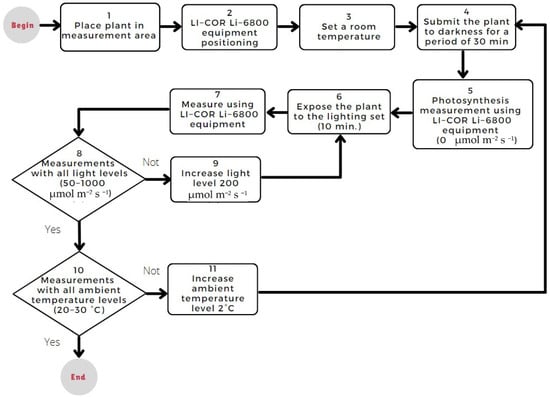
Figure 1.
Methodology of experimentation with jalapeño pepper plants for data collection with the LI-COR Li-6800 photosynthesis measurement equipment. Methodology based on reference experimentation [37].
2.2. Fuzzy Modeling
Among the soft computing methodologies, the ones that currently have the most significant relevance are fuzzy logic and neurocomputing, which lead to neuro-fuzzy systems. Within fuzzy logic, these methods are essential to induce rules from observations, allowing the creation of fuzzy systems from experimental observations. The main objective of this study is to predict the variation of the photosynthetic rate in chili plants through a fuzzy mathematical model. The proposed model is based on the following input variables:
- Soil moisture (SM). It influences the health of plants by providing the conditions required to transport nutrients from the roots to the stems, leaves, and fruits [38,39].
- Ambient temperature (AT). It affects plant temperature, although they are generally different [16,39].
- Incident radiation (R). Also known as light intensity (LI), it is a reference for climatic conditions and a key factor for internal processes such as photosynthesis, temperature regulation, and transpiration. It is the primary source of energy for photosynthesis [36].
- Leaf relative humidity (RH). It is a plant response related to its transpiration [36].
- Leaf temperature (LT). It is one of the main factors related to photosynthesis. The photosynthetic capacity decreases as the temperature of the leaves increases due to an increase in the respiration rates of the plant. Therefore, the enzymes are inactivated, reducing carbon fixation [30].
The mathematical model presented in this study uses fuzzy logic techniques since it is conceptually easy to understand, is flexible with any given system, tolerates inaccurate data, and models non-linear functions of arbitrary complexity. The goal of fuzzy logic is to map an input space to an output space, and the primary mechanism for doing this is a list of (if-then) statements called rules [21].
According to Wang [40], fuzzy systems are those systems that contain relations with terms and fuzzy logic. The fuzzy system, known as Takagi-Sugeno, was proposed in 1985. In this system, the rules are the main distinction. A typical rule in a fuzzy Sugeno model is shown in Figure 2.
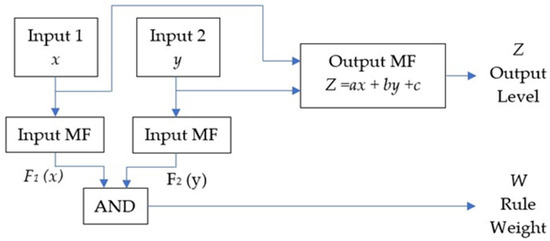
Figure 2.
Block diagram of the Takagi–Sugeno fuzzy model rule, with two inputs: Input 1 is x and Input 2 is y, the associated rule weights W, and the output level Z.
According to Figure 2, if Input 1 is x and Input 2 is y, then the output is Equation (2):
Z = ax + by + c
For a zero-order Sugeno model, the output level Z is a constant (a = b = 0). Each rule weights its output level Zi by the rule’s firing power, Wi. The final result of the system (Equation (3)) is the weighted average of all the results of the rule, calculated as:
where N is the number of rules, Wi is the normalized degree of rule contribution, and Zi is the output level [21].
The fuzzy photosynthesis model in jalapeño peppers used Equation (3) since it is flexible with any given system. The resulting model was a Sugeno-based model of sixth degree. The output level (Z) is a constant multiplied by each rule’s normalized degree of contribution (W). Finally, the parameters allowed us to calculate the weighted average of the system’s output.
Figure 3 shows the diagram of the fuzzy model for estimating photosynthesis in jalapeño pepper, composed of the input variables SM, AT, R, RH, and LT, as explained at the beginning of Section 2.2. In addition, the model includes an input variable P-1 to generate feedback and thus establish a dynamic model that depends on the previous state of photosynthesis.
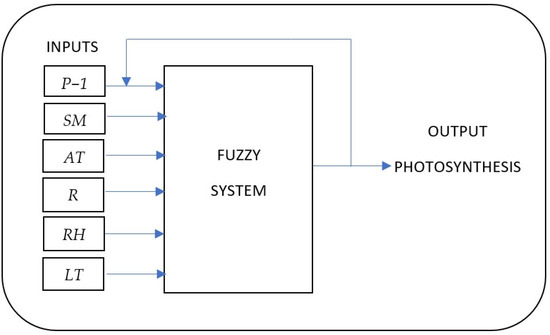
Figure 3.
Diagram of the fuzzy model for estimating photosynthesis in jalapeño pepper, composed of the input variables feedback (P-1), soil moisture (SM), ambient temperature (AT), incident radiation (R), relative humidity (HR), and leaf temperature (LT).
2.3. Methodology for the Fuzzy Model
This research used a systematic approach. The steps to develop the fuzzy model of jalapeño pepper photosynthesis based on the Takagi-Sugeno model are as follows:
- Model training. Once the input/output data from the experimentation have been collected, we must start by loading a training data set. This set must be 85% of the total input/output data collected [41]. Any dataset you load must be a matrix, with the data arranged as column vectors and the output data in the last column. Therefore, the ANFIS tool is used to train the FIS (fuzzy inference system) model and can emulate the training data presented to it by modifying the parameters of the membership function according to a chosen error criterion.
- Validation of the model. For this task, the validation used a different data set than the ones used in the training. In this case, it was 15% of the total input/output data [41]. Such a dataset was tested by the MATLAB function evalfis and the MATLAB code generated with our proposal.
- Inference system. The fuzzy logic toolbox GUI tool is helpful for building, editing, and viewing the FIS model generated in step 2.
- Fuzzy logic designer (fuzzification). Declare the input and output variables of the fuzzy inference system.
- Membership functions. Define the forms of all membership functions associated with each input and output variable for the entire fuzzy inference system.
- Fuzzy rules. Build the rule statements that define the behavior of the system.
- Fuzzy inference diagram. Use the rule viewer as a diagnostic to see how the shapes of individual membership functions influence the results.
- Simulation. After obtaining the inference system, simulate the fuzzy model based on Equation (3) and compare its output with the outputs of the LI-COR Li-6800 apparatus for model fitting.
- Verification. Compare the output of the implemented fuzzy model with the results of the simulations using experimental data.
To train an FIS, you must start by loading the training dataset. Therefore, specify a structure for the FIS model. Once the software obtains the structure of the model, it begins to train the FIS. In this step, we chose the hybrid optimization method, which consists of a combination of least squares and the backpropagation gradient descent method. The software stops training if it reaches the designated epoch number or if it reaches the error target.
A FIS comprises inputs, a knowledge base, inference rules, and outputs. For the Takagi–Sugeno model, membership functions that can be triangular, and Gaussian, among others, are used as inputs. Each entry should have as few membership functions as possible to speed up processing. The knowledge base contains the information necessary for the inference rules to decide the weight given to each input value. Finally, the output will be the weighted average of the inputs.
3. Results
3.1. Results of Data Collection and Experimental Setup
Forty-eight response curves were obtained and analyzed from the measured data. Figure 4 shows that jalapeño pepper tends to photosynthesize more at temperatures of 24 °C, with 100% soil moisture, because these are the most suitable environmental conditions for these plants. The negative behavior of photosynthesis is the result of the absence of light, because photosynthesis is not active. This reaction allows the start of a process called photorespiration. Photorespiration is a process contrary to photosynthesis, since instead of fixing carbon, it causes carbon loss [42].
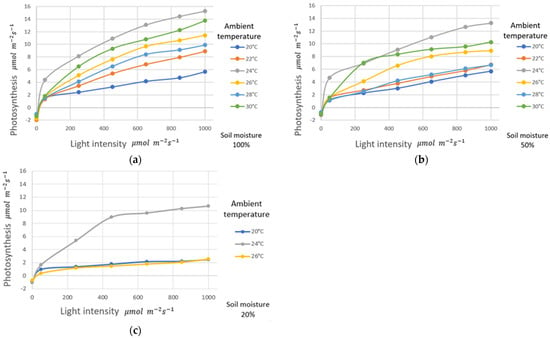
Figure 4.
The behavior of photosynthesis in jalapeño pepper plants at different levels of light intensity, ambient temperature, and soil moisture. (a) Soil moisture 100%, (b) soil moisture 50%, (c) Soil moisture 20%.
Leaf temperature is one of the main factors related to photosynthesis and is closely related to ambient temperature; Figure 5 verifies this. Then the ambient temperature and the leaf temperature have a proportional relationship, since as the ambient temperature increases, the leaf temperature also increases.
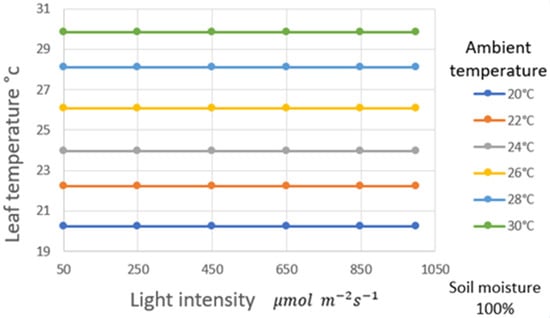
Figure 5.
The behavior of leaf temperature in jalapeño pepper plants at different light intensity levels, ambient temperature, and 100% soil moisture.
Regarding the leaf, environmental factors such as those of the plant influence transpiration efficiency. Relative humidity is a plant response related to its transpiration. A reduction in relative humidity causes an increase in transpiration and a decrease in photosynthesis, which reduces transpiration efficiency [43]. Therefore, at high air temperatures, relative humidity decreases, thus reducing transpiration efficiency (Figure 6).

Figure 6.
The behavior of the relative humidity of the leaf in jalapeño pepper plants at different levels of light intensity, ambient temperature, and 100% soil humidity.
3.2. Fuzzy Modeling Results
The design of the present photosynthesis model, which implements fuzzy logic, consists of two membership functions for each input variable with an output of constant type. The FIS model with two membership functions was chosen because, if the number of membership functions increases, then the number of rules that define the system’s behavior also increases, resulting in the generation of a fuzzy system that is more complex to implement (which is undesirable). After testing several options and achieving the minimum training error, the chosen number of training epochs was 300, since the tolerance to training error was zero at this level. The mean square error (RMSE) [43] of the training data set at each epoch was 1.0129. Figure 7 shows the structure of the resulting model. The ANFIS application graphical interface generates the FIS parameters automatically. In our case, the result of the method yielded a structure of six input variables with two membership functions each, one output variable, and a total of 64 fuzzy rules.
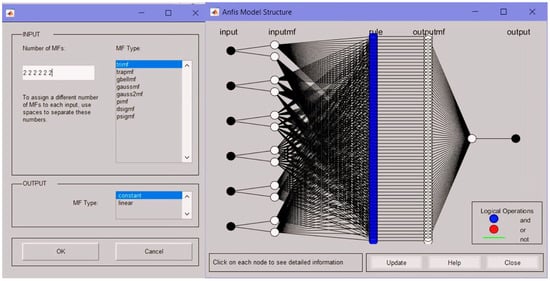
Figure 7.
Structure of the FIS model to estimate photosynthesis, with 6 input variables with two membership functions each, one output variable and a total of 64 fuzzy rules, using the ANFIS tool in MATLAB.
Figure 8 shows the diagram of the fuzzy inference system loaded in the neuro-fuzzy designer tool with the names of each input variable on the left and the output variable on the right. In the case of this investigation, the FIS membership functions associated with the input variables are triangular. This triangular function is a set of three points that form a triangle, so it has the advantage of simplicity.

Figure 8.
Diagram of the fuzzy inference system, which consists of the input variables (SM, AT, R, LT, RH, P-1), the Sugeno model, and the output (the estimation of photosynthesis).
The rule viewer allows users to experiment with individual membership features to select the best option. In Figure 9, each column is an input variable, each row is an inference rule, and the yellow plots show the output membership functions corresponding to each rule’s antecedent. The last column (blue graph) represents the aggregate weighted decision for the given inference system. This decision will depend on the input values for the system. Also, Figure 9 shows the variables and their current values at the top of the columns. There is a text field at the bottom left where you can enter specific input values for the FIS to perform tests and verify the operation of the model.
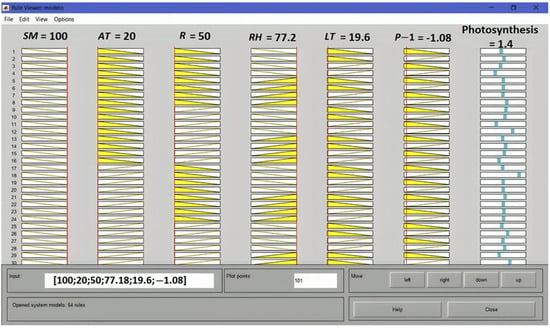
Figure 9.
Rule viewer that interprets the entire fuzzy inference process, applying specific test values to the input variables, and verifying the operation of the model.
Figure 10 shows the FIS file created with the support of the ANFIS tool. This figure describes part of the ranges of each variable, the functions, the constant outputs, and the rules.
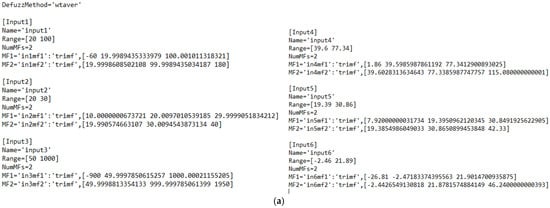
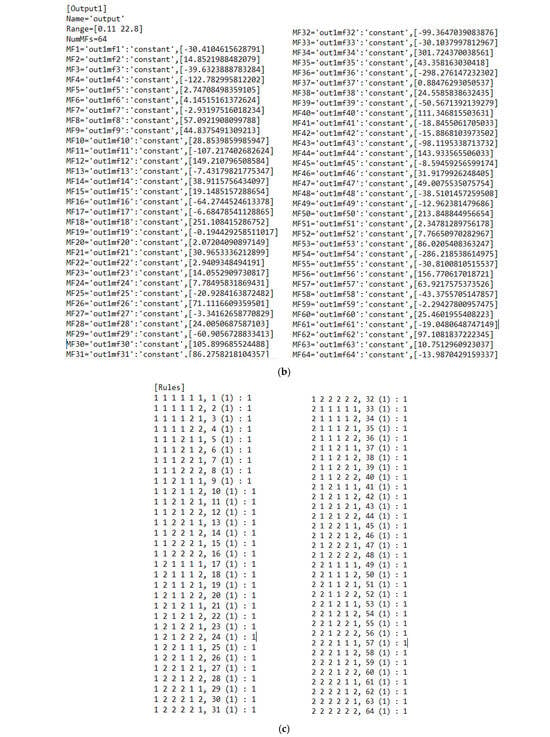
Figure 10.
FIS file generated with the ANFIS tool. (a) Input parameters, (b) constant type output levels, (c) fuzzy system rules.
ANFIS needs some hyperparameters to find the parameters of the FIS model. These hyperparameters are the number of membership functions in each input, types of membership functions in each input, training epochs, a constant or linear output, and training stop error, among others. The literature suggests taking 85% of the data for training and the remaining 15% for model validation to generate reliable models [41]. Figure 11 shows the comparison graph between the LI-COR Li-6800 and the proposed FIS model. The statistical analysis shows a correlation coefficient (R2) of 0.95.
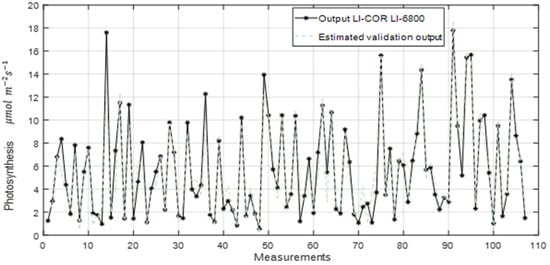
Figure 11.
Comparison of the measurements made by the LI-COR Li-6800 and the FIS model using the ANFIS tool. One hundred and seven measurements correspond to 15% of the total input/output data.
Figure 12 shows that the estimated photosynthesis obtained by the proposed fuzzy system correctly fits the shape of the data obtained with the LI-COR Li-6800. The evaluation from the experimentation with jalapeño pepper plants and the quantitative analysis of the graphs shown in Figure 12 arise from comparing the measurements obtained with the LI-COR Li-6800 equipment and the proposed fuzzy model. The statistical data show a coefficient of determination (R2) of 0.95, proving that the fuzzy model for measuring photosynthesis is a reliable option for estimating this variable in jalapeño pepper plants.
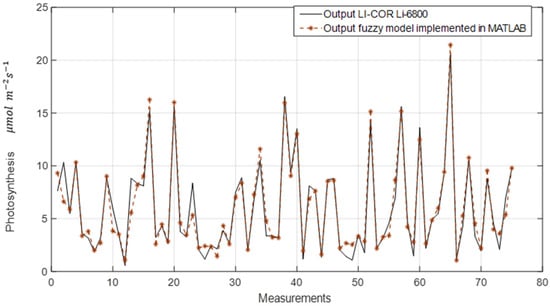
Figure 12.
Comparison of the measurements made by the LI-COR Li-6800 and the model’s output implemented in MATLAB.
4. Discussion
Estimating photosynthesis is not easy since many factors influence its approach. There are many efforts to evaluate photosynthesis through different mathematical models [2] that allow us to contribute to this objective. One of the most prominent is the Farquhar et al. model [4,44], the pioneer in estimating photosynthesis. The input variables used for this photosynthesis estimation model in C3 species are ambient temperature, CO2 concentration in the leaf, light intensity, and oxygen concentration in the leaf. Unfortunately, the parameters in Farquhar et al.’s model are difficult to estimate because they use various biochemical reactions and also use invasive measurement techniques for plants. Another disadvantage is that it involves a long and complex mathematical calculation, which is unfavorable for its implementation [2].
Liu et al. [45] present a model of the photosynthetic light response of the Olgensis L. tree canopy; it was constructed by linking leaf temperature, vapor pressure deficit, leaf mass per area, and the relative depth in the cup. The model performed well, with a coefficient of determination (R2) value of 0.883; however, it showed some weakened physiological and biochemical processes during photosynthesis. The LI-COR Li-6400 portable photosynthesis system validated this model.
Sánchez et al. [46] analyzed the influence of culture conditions (irradiation, temperature, pH, and dissolved oxygen) on photosynthesis in microalgae. It was possible to adjust the model to the experimental results in the range of culture conditions tested, and they were validated using the data obtained by the simultaneous modifications of the variables. The Statgraphics Centurion XVI software package analyzed the data in which non-linear regression fitted the experimental data to the model. This model presented a determination coefficient (R2) of 0.873 between experimentally measured photosynthesis and the approximate one. The mathematical calculation regarding this model is simple, unlike those mentioned previously; despite this, it presents a lower coefficient of determination than the model presented in this document.
In Shimada et al.’s study [47], an empirical photosynthetic model was constructed, which was the product of variables such as photosynthetic photon flux density, air temperature, soil temperature, vapor pressure deficit, soil water content, and age to estimate the photosynthetic rate of P. pumila. The model analysis used the data recorded by the LI-COR Li-6400. The non-linear regression analysis estimated all the constants, obtaining a correlation coefficient (R2) of 0.86. The disadvantage is that the model developed in this study is not sufficient to predict photosynthetic production under climate change due to acclimatization to long-term temperature changes.
García et al. [37] present a black-box mathematical model to estimate net photosynthesis and its digital implementation. The model uses variables such as leaf temperature, relative leaf humidity, and incident radiation. The model was elaborated with data obtained from Capsicum annuum L. plants and calibrated using genetic algorithms. According to the evaluation, the correlation coefficient is greater than 0.98, resulting from the comparison with the LI-COR Li-6800 equipment. The digital implementation consists of an FPGA (field programmable gate array) for data acquisition and processing, as well as a Raspberry Pi for Internet of Things (IoT) and in situ interfaces; thus, generating a useful net photosynthesis measurement device with non-invasive sensors. García et al. [37] present an innovative, portable, and low-scale way to estimate the photosynthetic process in vivo, in situ, and in vitro, using non-invasive techniques. The mathematical model referring to García et al.’s [37] methodology demonstrated a good correlation with photosynthetic measurements from gas analysis; however, it is possible to refine it. The photosynthesis process involves a large number of variables, of which two have an important influence: soil humidity and ambient temperature. However, these two variables were not considered in the model proposed by García et al. [37], since it was developed under controlled conditions of constant ambient temperature and constant soil humidity. This scenario does not occur in the natural habitat of plants. Therefore, this model behaves unstable when altering such environmental conditions. Due to this, the fuzzy model that we present in this article results in an improvement of the mathematical model developed by García et al. [37]. It is important to remark that the authors of this article are aware that the proposed model does not attempt to cover all the steps of this important and complex process, which is photosynthesis, but does attempt to simplify it.
A helpful statistic to measure the global quality of a model is the coefficient of determination (R2) since it measures the proportion or percentage of variability in the experimental data [2]. To interpret these coefficients, R2 should have a value close to 1. The models previously described [4,45,46,47] proved to have an acceptable R2 (see Table 1); however, their techniques for measuring the input variables are invasive, altering the species’ photosynthesis process. These models are also non-adaptive, which means that it is difficult to add more functionality since it would imply starting the model generation from scratch. In contrast, the fuzzy model presented in this document uses non-invasive techniques to measure the variables of interest. This approach may allow us, in future experiments, to move away from invasive measurements of photosynthesis and map the real physiological parameters of interest. Non-invasiveness is expected to greatly reduce stress on plants during testing [37]. The non-invasive techniques that can be used to measure the variables of interest are the following:

Table 1.
Comparison of the proposal with other photosynthesis estimation works.
- Soil moisture (SMA). Some sensors measure soil moisture by the variation in its conductivity or capacitance. These sensors are considered semi-invasive since, for measurement, they have direct contact with the soil but not necessarily with the plant.
- Ambient temperature (AT). This variable can be measured using different kinds of sensors, for example bandgap, thermocouple, or RTD (resistance temperature detector) sensors. The measurement only requires bringing the sensor a considerable distance from the plant.
- Light intensity (LI). The measurement device for this variable can be a light sensor that combines a configurable silicon photodiode and a current to frequency converter in an integrated circuit. The measurement technique does not require any contact with the plant since, to detect the light intensity, it only needs to be placed in an area close to the light.
- Leaf relative humidity (RH). A capacitive sensor element is used to measure the relative humidity around the leaf. The measurement technique consists of bringing the sensor closer to a suitable distance to avoid stress on the plant.
- Leaf temperature (LT). The thermopile is a transducer that takes the IR light radiated by different bodies (which is proportional to the temperature of the body) and converts it into a voltage. The thermopile is a sensor that absorbs infrared energy from an object at wavelengths between 4 μm and 16 μm. In this way, thermopiles are non-invasive temperature sensors.
Furthermore, the developed model used fuzzy logic because the mathematical concepts behind fuzzy reasoning are elementary, it is easy to incorporate more functions without having to start over from scratch, it tolerates inaccurate data, it models non-linear functions of arbitrary complexity, can be combined with conventional control techniques, and is based on the qualitative description structures used in everyday language [40].
The developed fuzzy model can predict photosynthesis at different temperatures, soil moisture levels, and light levels. The fuzzy model adequately predicted the output values of the validation dataset (Figure 11).
The comparison made in Figure 12 shows that the estimation of photosynthesis in the jalapeño pepper plant, obtained using the fuzzy model, adequately approximates the behavior of the photosynthesis estimation from LI-COR Li-6800.
The statistical data in Table 1 prove that the fuzzy model for measuring photosynthesis is a reliable option for estimating this variable in jalapeño pepper plants.
The fuzzy system implemented addition, multiplication, division, and if statements. These operations allow the model to be implemented in several embedded electronic systems, such as microcontrollers, FPGAs, or others.
5. Conclusions
This study presents a mathematical model of photosynthesis in jalapeño pepper plants using fuzzy logic as a function of soil moisture (SM), ambient temperature (AT), incident radiation (R), relative humidity (RH), and temperature of the leaf (LT). These variables can be measured using non-invasive techniques, avoiding stress generation in the plant. It is essential to highlight that the relative humidity involved in the estimation of photosynthesis in the fuzzy model is a variable that has not been considered in the development of previous models [2], which implies something atypical in the literature.
An experimental study with jalapeño pepper plants (Capsicum annuum L.) proved that the model yielded the expected results. The proposed model was referenced and validated with measurements using the LI-COR Li-6800 apparatus based on a gas analysis method, which is the most referenced principle for measuring photosynthesis in commercial and research activities [16,32,33,48].
The proposed model was resolved from the measurements of nine plants. The experimentation consisted of three levels of soil moisture (100, 50, and 20%), six ambient temperature levels (30, 28, 26, 24, 22, and 20 °C), and seven light intensity levels. (0, 50, 250, 450, 650, 850 y 1000 µmol m−2s−1).
The proposed model reached a correlation coefficient (R2) of 0.95 compared to the LI-COR Li-6800, which means that the fuzzy model correctly follows the form of photosynthesis measured experimentally in the plants of the case study. It can also be noted that this R2 statistic obtained is better compared to other models reported in the literature (Table 1).
The results of this study demonstrate the effectiveness of modeling photosynthesis using the fuzzy logic technique. Fuzzy logic is characterized by simplicity, robustness, and low solution costs. Therefore, in the future, it could play an increasingly important role in the conception and design of systems whose performance is superior to that of systems designed by conventional methods.
The present development has potential use in the agricultural and greenhouse sectors, aligning with strategic projects, as well as highly important economic activities, both at the national and state level.
Author Contributions
Conceptualization, L.d.C.G.-R. and A.E.-C.; data curation, L.d.C.G.-R. and J.A.M.-V.; formal analysis, J.A.M.-V. and A.I.B.-G.; investigation, L.d.C.G.-R. and A.E.-C.; methodology, J.A.P.-M. and A.I.B.-G.; project administration, J.P.-O. and A.E.-C.; resources, J.P.-O. and A.E.-C.; software, L.d.C.G.-R. and J.A.M.-V.; supervision, J.P.-O., A.I.B.-G. and A.E.-C.; validation, L.d.C.G.-R.; visualization, L.d.C.G.-R. and J.A.P.-M.; writing—original draft, L.d.C.G.-R.; writing—review and editing, J.P.-O., A.I.B.-G. and A.E.-C. All authors have read and agreed to the published version of the manuscript.
Funding
This research was funded by Tecnológico Nacional de México: 5718.19-P.
Data Availability Statement
The data supporting the conclusions of this article will be made available by the authors on request.
Acknowledgments
The authors thank Consejo Nacional de Humanidades, Ciencia y Tecnología (CONAHCyT), Mexico, for the Ph.D. grant to L.d.C.G.-R., and J.A.M.-V.
Conflicts of Interest
The authors declare no conflicts of interest.
References
- Ryu, Y.; Berry, J.A.; Baldocchi, D.D. What is global Photosynthesis? History, uncertainties and opportunities. Remote Sens. Environ. 2019, 223, 95–114. [Google Scholar] [CrossRef]
- García Rodríguez, L.d.C.; Prado-Olivarez, J.; Guzmán-Cruz, R.; Rodríguez-Licea, M.A.; Barranco-Gutiérrez, A.I.; Perez-Pinal, F.J.; Espinosa-Calderon, A. Mathematical Modeling to Estimate Photosynthesis: A State of the Art. Appl. Sci. 2022, 12, 5537. [Google Scholar] [CrossRef]
- Stirbet, A.; Lazár, D.; Guo, Y.; Govindjee, G. Photosynthesis: Basics, history and modelling. Ann. Bot. 2019, 126, 511–537. [Google Scholar] [CrossRef]
- Farquhar, G.D.; Von Caemmerer, S.; Berry, J.A. A biochemical model of photosynthetic CO2 assimilation in leaves of C3 species. Planta 1980, 149, 78–90. [Google Scholar] [CrossRef]
- Chen, D.-X.; Coughenour, M.B.; Knapp, A.K.; Owensby, C.E. Mathematical simulation of C4 grass photosynthesis in ambient and elevated CO2. Ecol. Model. 1994, 73, 63–80. [Google Scholar] [CrossRef]
- Zufferey, V.; Murisier, F.; Schultz, H. A model analysis of the photosynthetic response of Vitis vinifera L. cvs Riesling and Chasselas leaves in the field: I. Interaction of age, light and temperature. VITIS 2000, 39, 19–26. [Google Scholar]
- Boonen, C.; Samson, R.; Janssens, K.; Pien, H.; Lemeur, R.; Berckmans, D. Scaling the spatial distribution of Photosynthesis from leaf to canopy in a plant growth chamber. Ecol. Model. 2002, 156, 201–212. [Google Scholar] [CrossRef]
- Ye, Z.P. A new model for relationship between irradiance and the rate of Photosynthesis in Oryza sativa. Photosynthetica 2007, 45, 637–640. [Google Scholar] [CrossRef]
- Bernacchi, C.J.; Rosenthal, D.M.; Pimentel, C.; Long, S.P.; Farquhar, G.D. Modeling the Temperature Dependence of C3 Photosynthesis. In Photosynthesis In Silico: Understanding Complexity from Molecules to Ecosystems, Advances in Photosynthesis and Respiration; Lais-k, A., Nedbal, L., Govindjee, Eds.; Springer: Dordrecht, The Netherlands, 2009; pp. 231–246. [Google Scholar] [CrossRef]
- LI-COR. Using the LI-6800, Portable Photosynthesis: User manual.LI6800 | Instruction Manuals. 2009. Available online: https://www.licor.com/env/support/LI-6800/manuals.html (accessed on 2 December 2022).
- Müller, J.; Braune, H.; Diepenbrock, W. Complete Parameterization of Photosynthesis Models—An Example for Barley. In Crop Modeling and Decision Support; Cao, W., White, J.W., Wang, E., Eds.; Springer: Berlin/Heidelberg, Germany, 2009; pp. 12–23. [Google Scholar] [CrossRef]
- Johnson, I.R.; Thornley, J.H.M.; Frantz, J.M.; Bugbee, B. A model of canopy photosynthesis incorporating protein distribution through the canopy and its acclimation to light, temperature and CO2. Ann. Bot. 2010, 106, 735–749. [Google Scholar] [CrossRef]
- García Camacho, F.; Sánchez-Mirón, A.; Molina-Grima, E.; Camacho-Rubio, F.; Merchuck, J.C. A mechanistic model of Photosynthesis in microalgae including photoacclimation dynamics. J. Theor. Biol. 2012, 304, 1–15. [Google Scholar] [CrossRef]
- Lombardozzi, D.; Sparks, J.P.; Bonan, G.; Levis, S. Ozone exposure causes a decoupling of conductance and photosynthesis: Implications for the Ball-Berry stomatal conductance model. Oecologia 2012, 169, 651–659. [Google Scholar] [CrossRef]
- Von Caemmerer, S. Steady-state models of Photosynthesis. Plant Cell Environ. 2013, 36, 1617–1630. [Google Scholar] [CrossRef]
- Serbin, S.P.; Singh, A.; Desai, A.R.; Dubois, S.G.; Jablonski, A.D.; Kingdon, C.C.; Kruger, E.L.; Townsend, P.A. Remotely estimating photosynthetic capacity, and its response to temperature, in vegetation canopies using imaging spectroscopy. Remote Sens. Environ. 2015, 167, 78–87. [Google Scholar] [CrossRef]
- Janka, E.; Körner, O.; Rosenqvist, E.; Ottosen, C.-O. A coupled model of leaf photosynthesis, stomatal conductance, and leaf energy balance for chrysanthemum (Dendranthema grandiflora). Comput. Electron. Agric. 2016, 123, 264–274. [Google Scholar] [CrossRef]
- FAO. Inicio | Organización de las Naciones Unidas para la Alimentación y la Agricultura, FAOHome. Available online: https://www.fao.org/home/es (accessed on 29 March 2022).
- Tron, E.; Margaliot, M. Mathematical modeling of observed natural behavior: A fuzzy logic approach. Fuzzy Sets Syst. 2004, 146, 437–450. [Google Scholar] [CrossRef]
- Dubois, D.; Nguyen, H.T.; Prade, H.; Sugeno, M. Introduction: The Real Contribution of Fuzzy Systems. In Fuzzy Systems: Modeling and Control; Nguyen, H.T., Sugeno, M., Eds.; Springer: Boston, MA, USA, 1998; pp. 1–17. [Google Scholar] [CrossRef]
- Fuzzy Logic ToolboxTM User’s Guide; The MathWorks, Inc.: Natick, MA, USA, 2018.
- Cepeda Negrete, J. Modelado de Sistemas Difusos de Múltiples Entradas y Salidas. Doctoral Dissertation, Universidad de Guanajuato DICIS, Salamanca, Mexico, 2011. Available online: https://www.aacademica.org/jcepedanegrete/7 (accessed on 15 August 2022).
- Sugeno, M.; Yasukawa, T. A fuzzy logic-based approach to qualitative modeling. IEEE Trans. Fuzzy Syst. 1993, 1, 7. [Google Scholar] [CrossRef]
- Center, B.; Verma, B.P. A fuzzy photosynthesis model for tomato. Trans. ASAE 1997, 40, 815–821. [Google Scholar] [CrossRef]
- Valenzuela, I.C.; Baldovino, R.G.; Bandala, A.A.; Dadios, E.P. Optimization of Photosynthetic Rate Parameters using Adaptive Neuro-Fuzzy Inference System (ANFIS). In Proceedings of the 2017 International Conference on Computer and Applications (ICCA), Doha, Qatar, 6–7 September 2017; pp. 129–134. [Google Scholar] [CrossRef]
- Kothari, S.L.; Joshi, A.; Kachhwaha, S.; Ochoa-Alejo, N. Chilli peppers—A review on tissue culture and transgenesis. Biotechnol. Adv. 2010, 28, 35–48. [Google Scholar] [CrossRef]
- West-Eberhard, M.J.; Smith, J.A.C.; Winter, K. Photosynthesis, Reorganized. Science 2011, 332, 311–312. [Google Scholar] [CrossRef]
- Zotarelli, L.; Dukes, M.; Morgan, K. Interpretación del contenido de la humedad del suelo para determinar capacidad de campo y evitar riego excesivo en suelos arenosos utilizando sensores de humedad. EDIS 2013, 2013. [Google Scholar] [CrossRef]
- Lardizabá, R. Manual de Producción de Chile Jalapeño; Centro de Desarrollo de Agronegocios: General Escobedo, Mexico, 2002. [Google Scholar]
- Espinosa-Calderon, A.; Torres-Pacheco, I.; Padilla-Medina, J.A.; Chavaro-Ortiz, M.; Xoconostle-Cazares, B.; Gomez-Silva, L.; Ruiz-Medrano, R.; Guevara-Gonzalez, R.G. Relationship between leaf temperature and photosynthetic carbon in Capsicum annuum L. in controlled climates. JSIR 2012, 7108, 528–533. [Google Scholar]
- Snider, J.L.; Choinski, J.S.; Wise, R.R. Juvenile Rhus glabra leaves have higher temperatures and lower gas exchange rates than mature leaves when compared in the field during periods of high irradiance. J. Plant Physiol. 2009, 166, 686–696. [Google Scholar] [CrossRef]
- Singh, M.P.; Erickson, J.E.; Boote, K.J.; Tillman, B.L.; van Bruggen, A.H.C.; Jones, J.W. Photosynthetic Consequences of Late Leaf Spot Differ between Two Peanut Cultivars with Variable Levels of Resistance. Crop Sci. 2011, 51, 2741–2748. [Google Scholar] [CrossRef]
- Espinosa-Calderón, A.; Torres-Pacheco, I.; Padilla-Medina, J.A.; Osornio-Ríos, R.A.; Romero-Troncoso, R.d.J.; Villaseñor-Mora, C.; Rico-García, E.; Guevara-González, R.G. Description of photosynthesis measurement methods in green plants involving optical techniques, advantages and limitations. Int. J. Anim. Breed. Genet. 2014, 4, 1–10. [Google Scholar]
- Steiner, A.A. The universal nutrient solution. In Proceedings of the 6th International Congress on Soilless Culture, Lunteren, The Netherlands, 29 April–5 May 1984. [Google Scholar]
- Helliker, B.R.; Richter, S.L. Subtropical to boreal convergence of tree-leaf temperatures. Nature 2008, 454, 511–514. [Google Scholar] [CrossRef]
- Yamori, W. Photosynthetic response to fluctuating environments and photoprotective strategies under abiotic stress. J. Plant Res. 2016, 129, 379–395. [Google Scholar] [CrossRef]
- García-Rodríguez, L.D.C.; Prado-Olivarez, J.; Guzmán-Cruz, R.; Heil, M.; Guevara-González, R.G.; Diaz-Carmona, J.; Espinosa-Calderón, A. Black-Box Mathematical Model for Net Photosynthesis Estimation and Its Digital IoT Implementation Based on Non-Invasive Techniques: Capsicum annuum L. Study Case. Sensors 2022, 22, 5275. [Google Scholar] [CrossRef]
- Azcon Bieto, J.; Talón, M. Fundamentos de Fisiología Vegetal; McGraw-Hill., Interamericana: Barcelona, Spain, 2000. [Google Scholar]
- Taiz, L.; Zeiger, E.; Møller, I.M.; Murphy, A. Plant Physiology and Development; Sinauer Associates: Sunderland, CT, USA, 2015. [Google Scholar]
- Wang, L.X. Adaptive Fuzzy Systems and Control: Design and Stability Analysis; Prentice-Hall, Inc.: Upper Saddle River, NJ, USA, 1994. [Google Scholar]
- Escamilla-García, A.; Soto-Zarazúa, G.M.; Toledano-Ayala, M.; Rivas-Araiza, E.; Gastélum-Barrios, A. Applications of artificial neural networks in greenhouse technology and overview for smart agriculture development. Appl. Sci. 2020, 10, 3835. [Google Scholar] [CrossRef]
- Feng, L.; Raza, M.A.; Li, Z.; Chen, Y.; Khalid, M.H.B.; Du, J.; Yang, F. The influence of light intensity and leaf movement on photosynthesis characteristics and carbon balance of soybean. Front. Plant Sci. 2019, 9, 1952. [Google Scholar] [CrossRef]
- Chai, T.; Draxler, R.R. Root mean square error (RMSE) or mean absolute error (MAE)?—Arguments against avoiding RMSE in the literature. Geosci. Model Dev. 2014, 7, 1247–1250. [Google Scholar] [CrossRef]
- Farquhar, G.D.; Von Caemmerer, S.; Berry, J.A. Models of Photosynthesis. Plant Physiol. 2001, 125, 42–45. [Google Scholar] [CrossRef]
- Liu, Q.; Xie, L.; Li, F. Dynamic Simulation of the Crown Net Photosynthetic Rate for Young Larix olgensis Henry Trees. Forests 2019, 10, 321. [Google Scholar] [CrossRef]
- Sánchez-Zurano, A.; GómezSerrano, C.; Acién-Fernández, F.G.; Fernández-Sevilla, J.M.; Molina-Grima, E. Modeling of Photosynthesis and respiration rate for microalgae–bacteria consortia. Biotechnol. Bioeng. 2021, 118, 952–962. [Google Scholar] [CrossRef]
- Shimada, R.; Takahashi, K. Diurnal and seasonal variations in photosynthetic rates of dwarf pine Pinus pumila at the treeline in central Japan. Arct. Antarct. Alp. Res. 2022, 54, 1–12. [Google Scholar] [CrossRef]
- Zhang, Y.; Xiao, X.; Wu, X.; Zhou, S.; Zhang, G.; Qin, Y.; Dong, J. A global moderate resolution dataset of gross primary production of vegetation for 2000–2016. Sci. Data 2017, 4, 170165. [Google Scholar] [CrossRef]
Disclaimer/Publisher’s Note: The statements, opinions and data contained in all publications are solely those of the individual author(s) and contributor(s) and not of MDPI and/or the editor(s). MDPI and/or the editor(s) disclaim responsibility for any injury to people or property resulting from any ideas, methods, instructions or products referred to in the content. |
© 2024 by the authors. Licensee MDPI, Basel, Switzerland. This article is an open access article distributed under the terms and conditions of the Creative Commons Attribution (CC BY) license (https://creativecommons.org/licenses/by/4.0/).